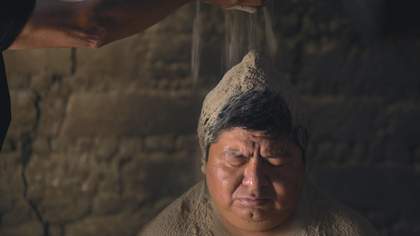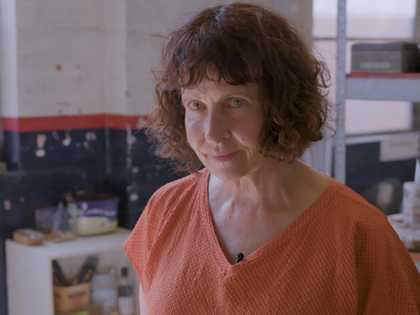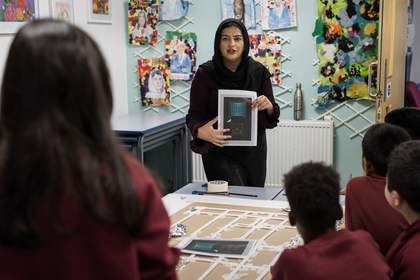We invited teacher Lyndsey Miles to explore Tate’s collection and select an artwork that could inspire creative activities and meaningful discussions about the environment and climate action.
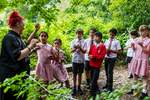
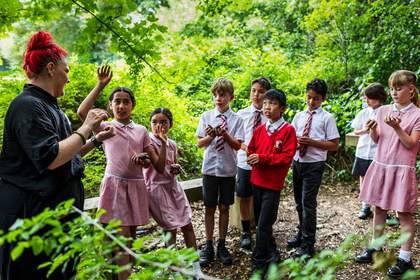
Teacher Spotlight: Edgar Calel
Explore conversations around the environment, natural materials, and climate action using prompts and activities devised by teacher Lyndsey Miles
About Lyndsey Miles
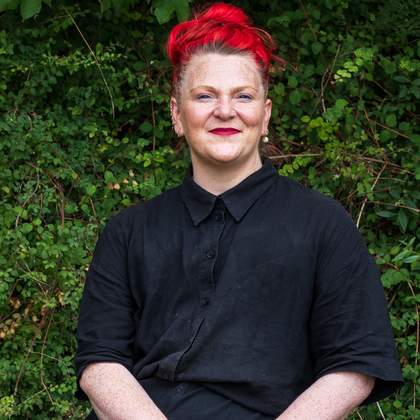
Photo © Hydar Dewachi
"I am an artist and an arts educator. A teacher with experience leading art programmes in various educational settings. My artistic practice explores human & environmental relationships.
I view clay as a metaphor for our connection to place - each piece documenting our environmental impact and shared histories."
About the artwork
-
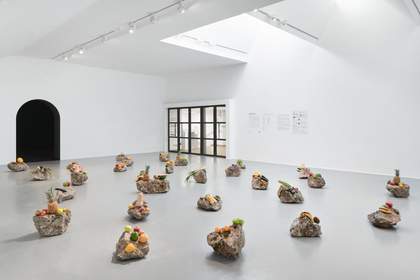
Artwork
The Echo of an Ancient Form of Knowledge
Edgar Calel2021
Edgar Calel makes art in community, with his family. His 2021 artwork, titled Ru k’ox k’ob’el jun ojer etemab’el (The Echo of an Ancient Form of Knowledge) offers fruits and vegetables atop stones as a gift of thanks to the land and his ancestors. Drawing on his Kaqchikel heritage, Calel brings together dreams, nature, and memory in his artwork, creating space for Indigenous knowledges to be acknowledged and respected.
"The work has narrative and storytelling at its heart; this appeals as a generosity of sharing"
Lyndsey Miles
Starting points
These prompts, devised by Lyndsey, model the different ways she would approach supporting her students to explore the themes in The Echo of an Ancient Form of Knowledge.
"I am keen to share and encourage that art can be sound; it can be performance; it can be a ritual"
Lyndsey Miles
- When we talk about climate change, what words come to our mind? What do these words mean? Collectively brainstorm words and then discuss their definitions. Write the words down to create your classroom glossary to help you have conversations around the climate and the environment.
- Edgar Calel uses materials drawn from the natural world, including fruit, stones, and mud. Why do you think it’s important to the artist to use natural materials in terms of the planet and climate action?
- What natural materials do you have access to in your classroom?
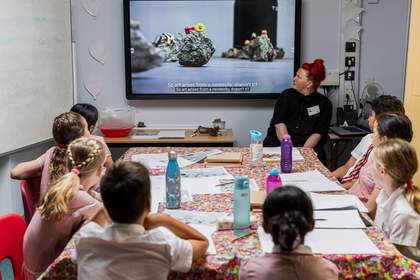
Photo © Hydar Dewachi
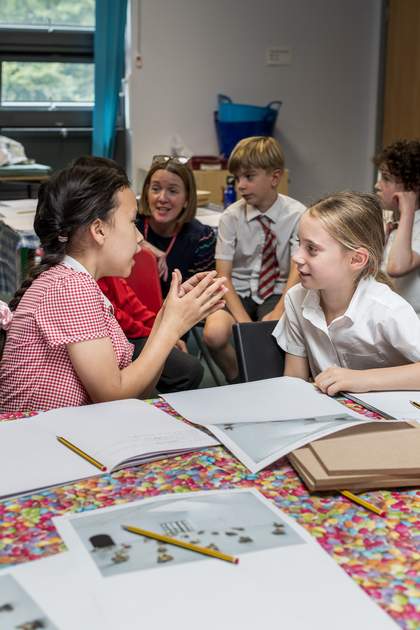
Photo © Hydar Dewachi
- Some people say that something sacred is something that matters to us, like nature, the earth, woods and rivers. What are some of the things that we, as humans, receive from nature, that help us live well? Make a list, drawing, or map together. Leave the drawing/list on display in the classroom for everyone to see while you continue to explore the artwork.
- How do you think it would feel to have a ‘conversation’ with the materials in an artwork: to slow down, listen to the materials, and say thank you to the materials and to the earth?
- Unless we are Kaqchikel, we won't have the same connection to their ceremonies, but Calel's work helps us think about rituals and giving thanks in our own lives. Have you given or received a gift, or participated in a ritual to say thank you? Were these moments tied to your family, cultural identity, or special interests?
Make
In this set of activities devised by Lyndsey, students are invited to create clay vessels, get in touch with nature, give thanks, and make an offering to the earth.
"Through working with earth-conscious materials, we can develop meaningful relationships with our surroundings, while addressing urgent climate concerns through art"
Lyndsey Miles
You will need
- Standard terracotta clay
- Basic mark making tools – can explore twigs, leaves and natural found items & your hands (your best tools!)
- Seeds
- Camera (take photographs/film performance)
- Paper and pencils to sketch ideas
- Bowls and water to re-hydrate and recycle the clay
- Homemade malleable material (Flour, water, salt, cornstarch, oil)
- Cob balls (damp clay, sand and grass/straw)
- Mud
Design your vessel
Duration: 30 Minutes
- The Echo of an Ancient Form of Knowledge is a sculpture and performance where Edgar Calel gives thanks to the earth and to his ancestors and makes offerings to them. During the performance Calel uses a vessel to bless the fruit he is offering in thanks. You can see the vessel (2mins 26 secs) in the film in this related resource.
- Gather inspiration for your vessel's shape. Consider cultural or family objects or items from nature, any form that resonates – seed pods, beehives, a censer or shells.
- Think about what you want to express gratitude for – perhaps your local park for its trees to climb, the sea for connecting distant countries or the air we breathe, which gives us life.
- Sketch out your ideas to help you decide on your vessel design.
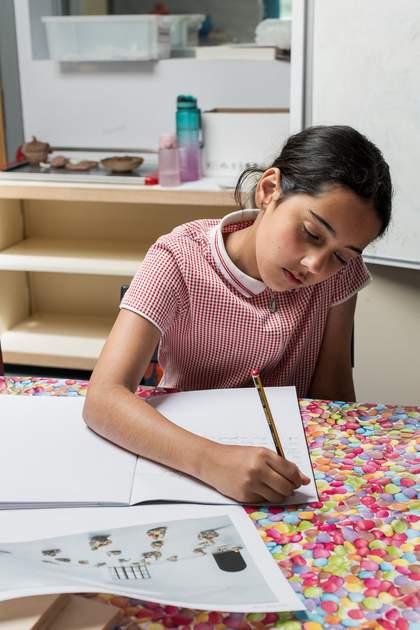
Photo © Hydar Dewachi
Make your vessel
Duration: 30-45 Minutes
- Sit in a circle around the clay placed in the centre. Take only as much clay as you need, being mindful that there's enough for everyone to share.
- Begin shaping your vessel with your hands. Listen to what the clay wants to become – how can you work together with the material to create something?
- Work slowly and mindfully, allowing the vessel to take form. Notice how the clay responds to your touch and how your original idea might evolve during the process.
- Place your vessel in a safe spot to dry completely. This may take 1-2 days depending on thickness and humidity.
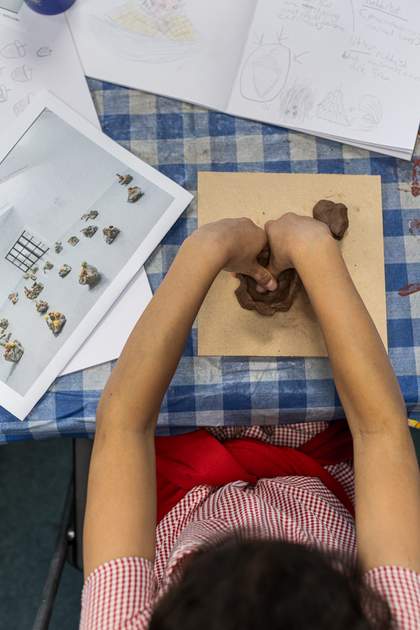
Photo © Hydar Dewachi
Adapt
You could provide clay that's easier to manipulate or pre-softened, or use mud you find outside or a mixture of flour and water.
You can create a visual guide showing different vessel shapes for inspiration. There are some examples from Tate's collection below.
Sweet Bowl, Patrick Caulfield, Still Life, Giorgio Morandi, Untitled, Veronica Ryan, Caterpillar Engine #1, Aaron Angell. Ideal Standard Forms, Edward Allington, Clay, bronze, wood and fabric, Jacqui Poncelet
Students can work in pairs, with one person describing ideas while the other shapes the clay.
"Slow working with natural materials is part of giving thanks, it is giving something precious to the earth - your time and care. They are related."
Lyndsey Miles
Fill Your Vessel
Duration: 30 Minutes
- Once it is dry, collect items to fill your vessel – seeds, written thank you notes, small found natural objects like shells or pebbles that represent your gratitude. If returning elements to the earth, what do you have to be mindful of?
- Fill your vessel with these meaningful items, thinking about your expression of thanks as you do so.
- You could design a class exhibition of the vessels before their final placement outdoors, if you wish.
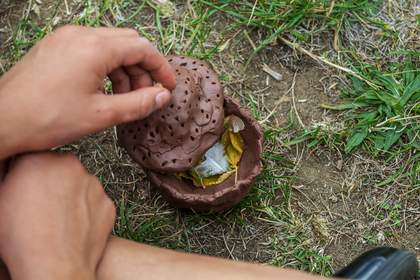
Photo © Hydar Dewachi
Give Thanks
Duration: 30 Minutes
- Outside in a special location, scatter your seeds or bury your vessels, while performing a simple gratitude ritual – perhaps a song, dance, or moment of silence to express your thanks to the earth.
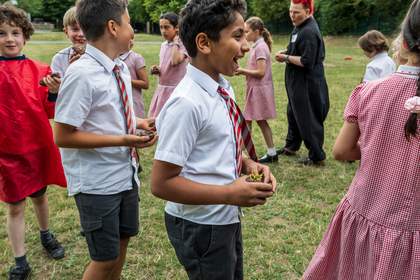
Photo © Hydar Dewachi
Extend
Research to enrich your activity.
- Calel’s work contains ancestral knowledge and cultural practices. Research vessels from different cultures and time periods, discussing their significance. Which vessels are connected to your ancestry and culture?
- Lots of schools use clay for sculpting, and clay is one of Lyndsey's favourite materials to work with. Where does clay come from? Look at examples of where clay can come from.
- How is clay used in our everyday lives? Search together for as many examples as possible.
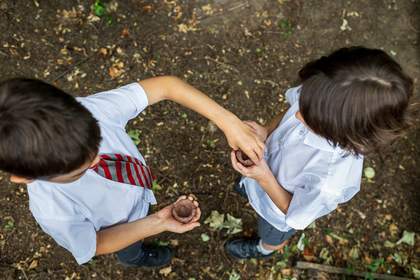
Photo © Hydar Dewachi
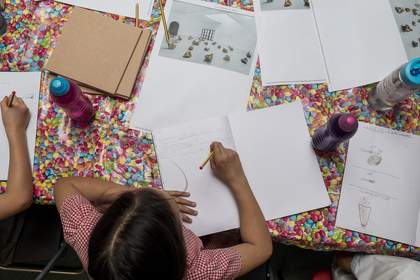
Write how you feel and record what changes.
- Create a gratitude journal to accompany your vessel, documenting your thoughts throughout the process.
- Throughout the school year, monitor seeds that were planted to observe growth cycles, connecting gratitude to nurturing, growth and change.
- Create a map of where vessels were placed, revisiting locations seasonally to observe changes and renew expressions of gratitude.
Make it Sensory
Additional options for Sensory Learners
Make seed balls – mash together seeds with mud, clay, or a mixture of flour and water.
Let students explore the feel and texture of the materials chosen. They could add pebbles, sticks, or other organic materials to their seed balls for additional interest.
Bury them together. You could bury them inside in a pot or outdoors depending on your context.
Consider multiple forms of gratitude rituals: students could choose sounds they like and make a soundscape to say 'thank you,' they could choose a gesture of thanks and make a movement piece, or they could listen to a song they like.
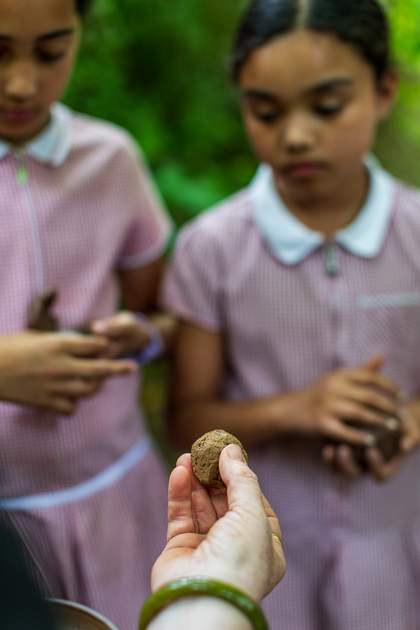
Photo © Hydar Dewachi
Lyndsey's Picks
Lyndsey has selected other works from the Tate collection and further classroom resources that relate to her interests in the materiality of clay, and in issues of climate action and environmental activism. Use them as inspiration or bring them into your classroom.
-
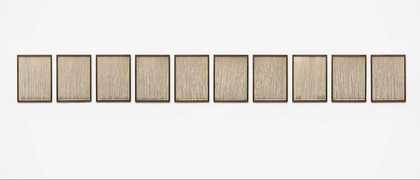
River Avon Mud drawings, Ten Mud-dipped papers
Richard Long CBE1988 -
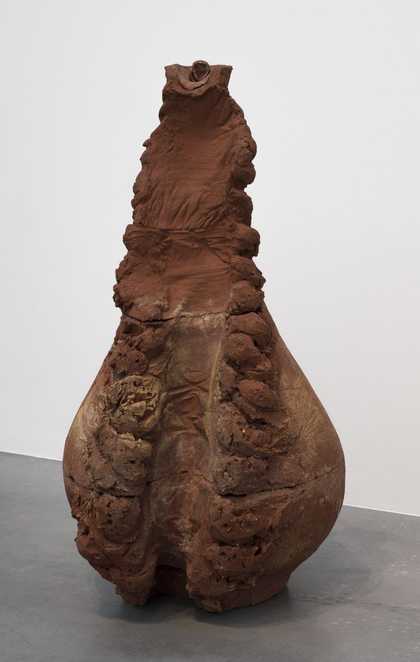
Breath 5
Giuseppe Penone1978
"Showing the artist's breath visualises how human existence depends on healthy ecosystems and clean air, elements threatened by climate change. This work offers a poetic entry point for discussing how environmental stewardship connects to social justice and the fair distribution of environmental benefits and burdens."
Lyndsey Miles
-
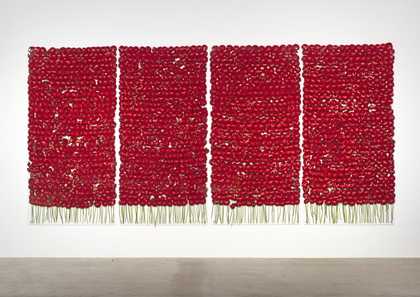
Artwork
preserve ‘beauty’
Anya Gallaccio1991–2003 -
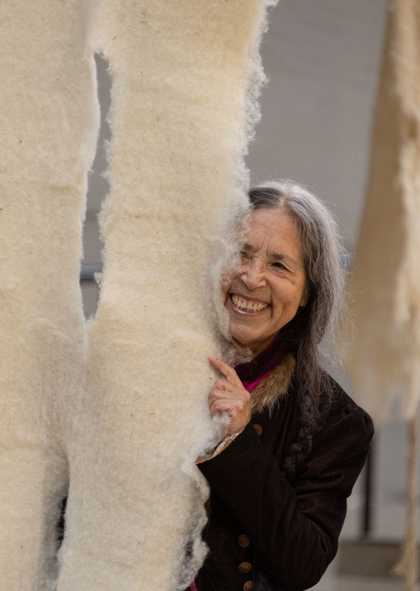
Cecilia Vicuña: Brain Forest Quipu
Delve deeper into the 2022 Turbine Hall commission
How to Use Teacher Spotlights
This resource offers a modular flexible approach: use the prompts and activities as a full sequence of lessons, choose a single idea to adapt for your classroom.
Teacher Spotlight resources are designed to increase your confidence in using Tate’s evolving collection to engage with big conversations in your classroom. Each resource is co-created with an expert teacher and shares real world examples of how they have successfully used the artworks in their teaching.
You are invited to draw inspiration and nourish your practice by seeing how other teachers approach working with artists and artworks in the classroom.

